Black Pepper: Insect and Nematode Pests Management
Black Pepper: Insect and Nematode Pests Management
Pollu beetle
Biology- Egg: Eggs are laid on the berries and lays 1-2 eggs in each hole, egg period 5-8 days.
- Grub: Grub period 30-32 days.
- Pupa: Pupation occurs in soil in a depth of 5.0 - 7.5 cm. Pupal period 6-7 days. Life cycle completed in 40 - 50 days. Four overlapping generations in a year.
- Adult: Adult is a bluish yellow shining flea beetles.
- The pollu beetle is a serious in black pepper plantations in the plains and at lower altitudes.
- The adults feed on tender shoots, spikes and berries.
- The infested shoots and spikes turn black and drop.
- The grub on emergence bore into the berries, feed on the internal contents and make them hollow.
- The infested berries turn yellow initially and then black and crumble when pressed.
- The pest population is more severe in shaded areas.
- During the period from January to April the adults do not breed but remain in the field feeding on older leaves.

- Predators: Spider (Araneae), Oecophylla smaragdina (weaver ant).
Top shoot borer
Biology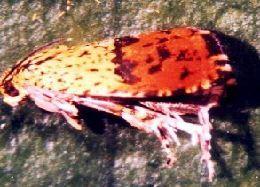 Egg: Eggs are small colourless.
Egg: Eggs are small colourless.- Larva: Larva grayish green, 12-14 mm long, larval period 10 -15 days. Pupates inside shoots.
- Pupa: Pupal period 8 – 10 days.
- Adult: Adult moth is tiny, forewing black with distal half red, hind wing greyish. Life cycle completed in a month.
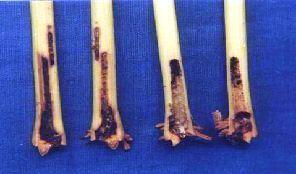 The adult is a fine moth with basal half of the forewing black and distal half orange red.
The adult is a fine moth with basal half of the forewing black and distal half orange red.- The top shoot borer is found more in younger plantations.
- The caterpillars of the moth bore into tender shoots which turn black and dry up.
- When successive new shoots are attacked, the growth of the vine is affected.
- The pest infestation is higher during July-November when numerous new shoots are available on the vines
- Parasitoid: Apanteles cypris, Eudederus sp. (Hymenoptera), Goniozus sp.
- Parasitic mite: Clinotrombium sp.(on larvae).
- Entomopathogenic nematode: Hexamermis sp.
Leaf gall thrips
Biology- Egg: Eggs are laid in single within the marginal leaf folds or on the leaf surface, egg period6-8 days.
- Nymph: Nymphs whitish and sluggish, nymphal period 9-13 days
- Pupa: Pupal period, 2 to 3 days
- Adult: Adults with heavily fringed wings. Adult longevity is 7-9 days.
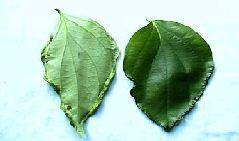 Infestation by leaf gall thrips is more serious at higher altitudes, especially in younger vines and also in the nurseries.
Infestation by leaf gall thrips is more serious at higher altitudes, especially in younger vines and also in the nurseries.- The feeding of thrips on tender leaves causes the leaf margins to curl down and inwards resulting in the formation of marginal leaf galls.
- The infested leaves become thick, malformed and crinkled
- Life stages of the insect can be seen within the gall.
- In severe cases of infestation, the growth of young vines is affected
- Parsitoids: Aphytis sp., Pseudoscymcus sp., Chilocorus circumdatus
- Predators: Montandoniola moraguesi, Androthrips flavipes, Geogarypus sp., Lestodiplosis sp., Rhodesiella sp, Predatory mites, Hoverflies, Thrips, Mirids.
Scale insect
Biology- Scales have unusual life cycles.
- The eggs are laid underneath the waxy covering and hatch over a period of one to three weeks.
- The newly hatched scales (called crawlers) move about over the plant until they locate succulent new growth.
- They insert their piercing-sucking mouthparts into the plant and begin feeding. Female scales lose their legs and antennae during the first molt.
- They moult a second time before reaching maturity and do not pupate.
- The cast skins (exuviae) are incorporated in the scale cover.
- Male scales go through two additional molts and pupate underneath the wax. Adult males are tiny two-winged, gnat-like insects without mouthparts.
- Pepper mussel scale: Lepidosaphes piperis : Scale is small, dark, boat shaped.
- Coconut scale: Aspidiotus destructor : Circular (about 1 mm in diameter) and yellowish brown.
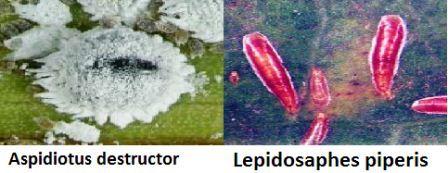
- Scale insects appear as encrustations on stems, leaves and berries
- They feed on plant sap resulting in yellowing and drying of infested portions of the vines.
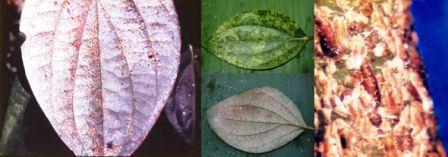
- Parasitoids: Encarsia lounsburyi, Aphytis sp. etc.
- Predators: Mite: Bdella sp., Thrips: Karnyothrips melaleucus, Aleurodothrips fasciatus, Beetle: Ladybird beetle, Chilocorus circumdatus, C.nigrita, Lacewings, Pseudoscymnus dwikalpa, Pharoscymna shorni, Sticholotisex anguis, Cybocephalus sp. etc.
Mealybugs
Biology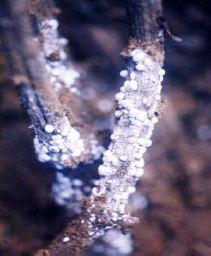 Egg: These eggs are yellowish to orange in colour
Egg: These eggs are yellowish to orange in colour- Nymph: The first instar nymphs are also called as crawlers, which are mobile. The total nymphal period is 19 days for male and 21 days for female. The male nymph forms a cottony cocoon in which the pupal stage is found mainly in the winter season
- Adult: The adult female mealybugs are pinkish white and sparsely covered with white wax. The male and female mealybugs are similar in early stages.
- The female passes through three nymphal instars while male passes through four nymphal instars.
- The adult male has a pair of wings and a pair of halters. Males are very rare and female mealybugs are commonly found causing the damage in the field.
- Mealybug completes the life cycle in about 30 days. Without mating, they are known to reproduce partheno-genetically throughout the year.
- Large number of mealy bugs colonise the roots of the vine (Plate 59)
- As a result of sap sucking, the plant turns yellow, leaves and branches dry and drop
- Many of the vines infested by root mealy bugs are also likely to be infected with Phytophthora and nematodes
- Parasitoid: Parasitic wasps,
- Predators: Hover flies, coccinellid (Cryptolaemus montrouzieri), praying mantis.
Root-knot nematode
Biology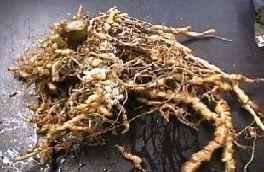 Most species of plant parasitic nematodes have a relatively simple life cycle consisting of the egg, four larval stages and the adult male and female.
Most species of plant parasitic nematodes have a relatively simple life cycle consisting of the egg, four larval stages and the adult male and female.- Development of the first stage larvae occurs within the egg where the first molt occurs. Second stage larvae hatch from eggs to find and infect plant roots or in some cases foliar tissues.
- Under suitable environmental conditions, the eggs hatch and new larvae emerge to complete the life cycle within 4 to 8 weeks depending on temperature.
- Nematode development is generally most rapid within an optimal soil temperature range of 70 to 80°F.
- Infected plants in patches in the field
- Formation of galls on host root system is the primary symptom
- Roots branch profusely starting from the gall tissue causing a ‘beard root’ symptom
- Infected roots become knobby and knotty
- In severely infected plants the root system is reduced and the rootlets are almost completely absent. The roots are seriously hampered in their function of uptake and transport of water and nutrients
- Plants wilt during the hot part of day, especially under dry conditions and are often stunted
- Nematode infection predisposes plants to fungal and bacterial root pathogens
- Primary: Egg masses in infected plant debris and soil or collateral and other hosts like Solonaceous, Malvaceous and Leguminaceous plants act as sources of inoculums.
- Secondary: Autonomous second stage juveniles that may also be water dispersed.
- Loamy light soils.
Burrowing nematode
Biology Burrowing nematode is an endoparasitic migratory nematode, meaning it completes its life cycle within root tissue.
Burrowing nematode is an endoparasitic migratory nematode, meaning it completes its life cycle within root tissue.- Adults and juveniles are vermiform in shape. Adults are sexually dimorphic. The male has a poorly developed stylet, a knob-like head, and a sharp, curved spicule enclosed in a sac.
- The male is 500 to 600 μm in length, while the female is about 550 to 880 μm long. The female has a well-developed stylet. Both male and female have long, tapered tails with rounded or indented ends.
- The nematode completes its life cycle in about 21 days at 25°C.
- Females and juveniles feed inside roots, especially near the tips. Males with their weak stylets do not feed. Females lay two to six eggs per day.
- The nematode causes a disease condition called toppling or blackhead disease in plants
IPM for Black Pepper
To know the IPM practices for Black Pepper, click here.
Source: NIPHM and Directorate of Plant Protection, Quarantine & Storage
Last Modified : 12/11/2019
© C–DAC.All content appearing on the vikaspedia portal is through collaborative effort of vikaspedia and its partners.We encourage you to use and share the content in a respectful and fair manner. Please leave all source links intact and adhere to applicable copyright and intellectual property guidelines and laws.
RELATED ITEMS
Black Pepper Pests
This topic covers the information related to Pest ...
Black Pepper
This topic provides the package of practices for c...
Nutritional Deficiencies/Disorders of Black Pepper
This topic covers the information related to Nutri...
Arecanut Insect Pests
This topic covers information about Arecanut Inse...
